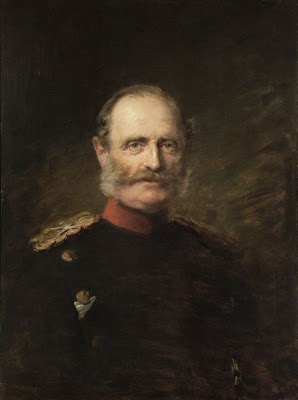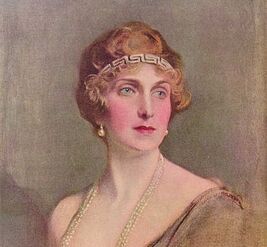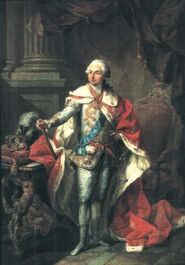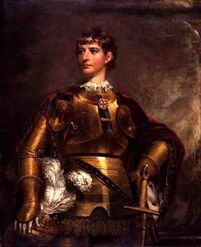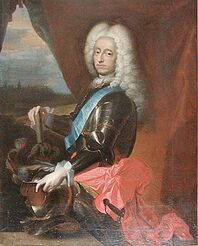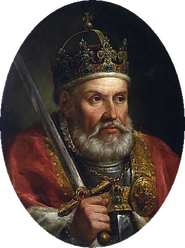The House of Hohensteinburg or House of Hohensteinburg-Colliete is a Noble Family and Dynasty of Kings, Archdukes and Emperors of Prussia, Aquitania, Lusitania, Azurnereich and Constantine, some of the States previously mentioned are no longer ruled by the House of Hohensteinburg, for example, Prussia and Azurnereich, while a cadet branch, the House of Souza, rules Constantine. They originated in the 7th Century. The Family took their name from their ancient Home Castle, Hohensteinburg, which means High Stone Castle in Azurni, Aquitanian, Prussian and Wassarian Languages, even though all four have notable differences. The House gained power as Azurnereich rose.
It was originally the "House of von Hohensteinburg", the preposition "von" was removed when the House began to rule Aquitania and it looked more appealing to the 2900's Aristocracy, who pressured the Dynastic Rulers to change it.
The House of Hohensteinburg ruled Azurnereich for Millennia until the Monarchy there was abolished, for a period they lived a peaceful life outside of politics until they were called to be crowned as the Aquitanian Ruling House in the year 2904 after the fall of the House of Wolfker. The Hohensteinburgs were widely accepted as the legitimate rulers of Aquitania and have been ruling for more than a century as Absolute Monarchs with occasional Advisory Councils.
In the year 2992, the Hohensteinburg Dynasty became the Ruling House of Imperial Lusitania after the latter's Confederate Union Collapsed due to a revolution. Then König Wilhelm II taking the title of Kaiser Wilhelm I of Lusitania.
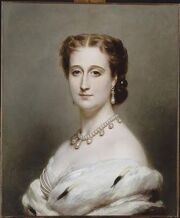
Kaiserin Consort Louise zu Strelitz
The Dynasty made an Official and Formal union with the Clan na Colliete of East Heaven through the marriage of Imperial Crown Prince Wilhelm Hohensteinburg and Heavenly Princess Maya na Colliete. The House of Hohensteinburg is sometimes popularly referred to by the Aquitanian Civilians as the House of Hohensteinburg-Colliete.
Constantine is ruled through a Union with the House of Souza, forming the Souza von Hohensteinburg Dynasty or House. Currently the branch ruling Constantine is the House of Souza, Hohensteinburg was dropped from the name after legal issues in the early 32nd Century.
The current Head of the House of Hohensteinburg-Colliete is Wilhelm IX, he is also the current Kaiser of Aquitania and Lusitania. He was crowned following the death of Kaiser Friedrich II and the abdication of his father; Wilhelm .
The Hohensteinburg Regime in Aquitania[]
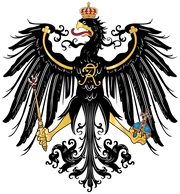
Dynastic Imperial Seal of the House of Hohensteinburg
After the death of the Wolfker dynasty, the Provisional Assembly called on all foreign nations to provide a royal blood noble or royal to be King of Aquitania. In the year 2904, immediately after the loss, the Old Azurni royalty expressed interest for the Aquitanian Throne and so became the first Hohensteinburg High King in Aquitania, His Majesty High King Friedrich Hohensteiburg.
In the year 2914, High King Friedrich Hohensteinburg collapsed the Empire of Aquitania with the help of the Provisional Assembly and the acclaim of the people, the same year, the Kingdom of Prussia was founded, he also introduced the Advisory Referendums to be better informed of the opinions of the Prussian social classes, a revolutionary reform in the government and the Prussian Assembly, considering the Absolutist nature of the monarchs. Friedrich Hohensteinburg is commonly being referred to as Friedrich Hohensteinburg the Great by the Prussian people.
After his death, his son: Wilhelm succeded him as King Wilhelm of Prussia in 2924 but died five years later in the SS Aquitania disaster, placing his wife, Queen Consort Katherina Courland as Queen Regent until their son, High Prince Alexander Augustus Hohensteinburg came of age to take the throne.
In the year 2934, Alexander succeded his mother as High King Alexander II Hohensteinburg of Prussia being just 17 years old, his reign was marked by economical reforms and the Stritchan Short Wars, where Prussia intervened to try and restore the Stritchan Presidential regime, in the year 2945, he helped develop the State of Aquitania in Greater UKO. By the year 2950, the King changed Prussia to Aquitania, the name that was used without interruption since the year 402, restored.
Reigning in prosperity, the sudden Higher Age ended in the year 3030 when a sudden and completely unexpected Republican Surge caused unrest and the overthrow of the House of Hohensteinburg as the rulers of Aquitania, the entire Royal Family evacuated to Lusitania, where they continue to rule as the Imperial Family, Emperors of Lusitania and Kings of Altehaupt.
Following a relaxation of Anti-Monarchism in the Aquitanian Nation, a Plebiscite was held and 87% of the people voted for the Return of the Monarchy under the Federal Republican System that was established in the year 3030. The Kaiserin of Lusitania accepted ad was crowned Königin Maya Elisabeth na Colliete I.
Timeline of Rulers of Aquitania[]
High Monarchs of Arlathan
Grand King Tridius Wolfker the Great (402-447)
King Alfred Wolfker the Wise (447-468)
Queen Lilian Wolfker (468-500)
King Alfred II Wolfker (500-540)
King Jakob Wolfker (540-598)
King Jakob II Wolfker (598-620)
King Karolus Wolfker (620-657)
Königen of the Kingom of Arlathan and High Lords of the Nordlanderbund
King Albrecht Wolfker (657-673)
King Albrecht II Wolfker (673-701)
King Alfred III Wolfker (701-734)
King Karolus II Wolfker (734-763)
Queen Aveline Wolfker (763-805)
King Albrecht III Wolfker (805-857)
King Albrecht IV Wolfker (857-903)
King Albrecht V Wolfker (903-947)
King Albrecht VI Wolfker (947-997)
King Alfred IV Wolfker (997-1045)
King Alfred V Wolfker (1045-1089)
King Alfred VI Wolfker (1089-1120)
King Alfred VII Wolfker (1120-1186)
King Karolus III Wolfker (1186-1213)
King August the Great Wolfker (1213-1267)
King August II Wolfker (1267-1314)
Queen Elsbeth the Longlived Wolfker (1314-1429)
King Alfred VIII Wolfker (1429-1500)
Kaisers of the First Greater Aquitanian Empire 1507-2467 (Grossaquitanisches Reich)
Kaiser Richard Wolfker the Great (1500-1534)
Kaiser Richard II Wolfker the Strict (1534-1622)
Kaiser Richard III Wolfker (1622-1699)
Kaiserin Elizabeth Wolfker (1699-1798)
Kaiser Alfred IX Wolfker (1798-1864)
Kaiser Richard IV Wolfker (1864-1934)
Kaiser Alfred the Tenth Wolfker (1934-2005)
Kaiserin Morrigan Wolfker the Great (2005-2114)
Kaiser Anton Wolfker the Great (2114-2163)
Kaiser Anton II Wolfker (2163-2235)
Kaiser Anton III Wolfker (2235-2309)
Kaiser Anton IV Wolfker (2309-2400)
Kaiser Anton V Wolfker (2400-2467)
Collapse of the First Empire (2467)
Great Schism (2467-2809)
Kaiserin Johanna Antoinette the Great (2467-2597)
Kaisers of the Second Aquitanian Empire (Aquitanisches Reich)
Kaiser Alfred XII Wolfkehr (2745-2810)
Kaiser Richard VIII Wolfkehr (2810-2864)
Kaiser Alexander Wolfkehr (2864-2900)
Kaiserin Morrigan II Wolfkehr (2900-2904)
End of the Wolfker Dynasty
Fall of the Second Empire
Beginning of the Hohensteinburg Dynasty
Königen of the Kingdom of Prussia (Königreich Preussen)(2014-2950)
König Friedrich Hohensteinburg (2904-2923)
König Wilhelm Hohensteinburg (2924-2929)
Königen of the Second Kingdom of Aquitania (Königreich Aquitanien)
König Alexander II Hohensteinburg (2929-2982)
König Wilhelm II Hohensteinburg (2982-3017)
König Wilhelm III Hohensteinburg (3017-3030)
König Wilhelm IV Hohensteinburg (3040-3041)
Kaisers of the Third Aquitanian Empire (Aquitanisches Reich)
Kaiser Wilhelm III Hohensteinburg (3030-3041)
Kaiserin Maya Elisabeth na Colliete (3041-3127)
Kaiser Wilhelm V Hohensteinburg-Colliete (3127-3143)
Kaiser Wilhelm VI Hohensteinburg-Colliete (3143-3154)
Kaiser Friedrich II Hohensteinburg-Colliete (3154-3241)
Kaiser Wilhelm VII Hohensteinburg-Colliete (3241-3301)
Kaiser Wilhelm VIII Hohensteinburg-Colliete (3301-3340)
Kaiser Wilhelm IX Hohensteinburg-Colliete (3340-Present)
Timeline of Kaisers and Kaserins of Lusitania[]
Confederacy Dissolved and Empire Proclaimed
Kaiser Wilhelm Hohensteinburg (2992-3017)
Kaiser Wilhelm II Hohensteinburg (3017-3040)
Kaiser Wilhelm III Hohensteinburg (3040-3041)
Kaiserin Maya Elisabeth I na Colliete (3041-3127)
Kaiser Wilhelm IV Hohensteinburg-Colliete (3127-3143)
Kaiser Wilhelm V Hohensteinburg-Colliete (3143-3154)
Kaiser Friedrich II Hohensteinburg-Colliete (3154-3241)
Kaiser Wilhelm VI Hohensteinburg-Colliete (3241-3301)
Kaiser Wilhelm VII Hohensteinburg-Colliete (3301-3340)
Kaiser Wilhelm VIII Hohensteinburg-Colliete (3340-Present)
Renowned Imperial Members[]
Members of the Imperial Family recognised and highly praised by the Aquitanian Public during their reign and years after their death.
König Friedrich Hohensteinburg der Grosse

Friedrich der Grosse, 2920

Friedrich immediately adopted the Prussian Pickelhelm. Here receiving a communique, 2911 Advance on Lux Holy City
The first Hohensteinburg King of Prussia and first Hohensteinburg ruler of Aquitania, in the later years of his reign he was frequently referred to as "The Great" (Der Grosse) and is widely remembered for bringing order to a country that was spiraling out of control during the Second Great Schism. He was born in Valhalla, Azurnereich on March 8th, 2846; and was styled "Friedrich August von Azurnereich", since his country had abolished the monarchy for some time in the 2800's, he exercised no political power. The future king had an impecable military career, and had many hobbies, his family being very wealthy; he enjoyed popular sports like car racing, polo and piloting. Eventhough the official and claimed status of his family was void in his country, he attended socio-political events and excersised great influence on powerful businessmen and politicians, meeting frequently with Doug Thomas, leader of Azurnereich.

Queen Alexandra, Crown Prince Wilhelm and Prince Friedrich, 2882
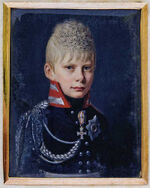
Prince of Prussia, Alexander Wilhelm August, Favourite Grandson of Friedrich I, 2912; Future King Alexander II
In 2904, after the death of Kaiserin Morrigan Wolfkehr II, he was invited and encouraged by the Imperial Ambassador to Azurnereich to accept the Crown of Prussia, after Hall of Dyrant (Dyranttag) determined the country (Azurnereich) and him, an Aquitanian ally with cultural and linguistic similarities too close to ignore, a suitable candidate. In 2903, the prime candidates for the Imperial Crown were one of the Royal Families of the four Kingdoms excluding Prussia; namely Ludonnia, Wulffbein and Vladien; but hostilities between the Imperial Forces and Wulffbein had erupted the same year, so the Hall of Dyrant decided to place Friedrich in the Prussian Throne a few months following the Imperial invasion of Kahltforien (then in Wulffbein) in the year 2904. The prime factors that convinced the Hall of Dyrant to hand Friedrich the crown of Prussia were the following: The Prussian House of Asterien had been driven into exile following the 2892 break out of turmoil in the Second Aquitanian Reich and offering the Imperial Crown was a risk too high for the Hall of Dyrant to undertake, yet the Imperial Crown would not be handed to any King of the three Kingdoms since many noble families would never recognise their rival counterparts. Hence the Empire was officially dissolved and the territory surrounding Arkadien, bulk of the Imperial Army, was declared the Grand Duchy of Arlathan and continued its feud with the newly Independent Kingdom of Wulffbein.
Having had a militaristic upbringing, Friedrich, a month after his arrival and being crowned Friedrich I, speaking to crowds of Prussians with his sharp Azurni Accent, convinced them of the danger the other Aquitanian Kingdoms and Duchies posed to the security of the realm (Prussia) and told them to lift up their Prussian pride, long buried by Imperial Hegemony, the crowds cheered him ecstatically. A day later, the Prussian Army was mobilised on the newly established Republic of Savoy, which had so far claimed neutrality in the fresh Arlathii-Wulffbein Conflict in the east. Knowing that such opportunity would never show up in the future, Friedrich took advantage of Vladish and Ludonnian concerns over the conflict on their Eastern backyards and invaded Savoy on July 24th, 2904. His favourite grandson, Alexander August, always featured with him in the fields of battle ever since he turned 8 years old, much to the protest of his daughter in law. His grandson made his military debut in the year 2910 during the siege of Straussstadt, bringing defeat to Ludonnia on March and invading Vladien in August the same year to be upon the Lux Holy City by the beginning of 2911.
Friedrich the Great's eventual military success and Prussian domination of the entire territorial composition of the former Second Aquitanian Reich brought great praise and deity like admiration by the Aquitanian public, particularly that of Prussians. He died in the year 2923, age 77 and was succeeded by his son Wilhelm I (born 2868). Wilhelm I died in the SMS Aquitania disaster just five years into his reign and was succeded by Alexander II, the sole survivor of the sinking along with his mother. Consipiracy and mystic believers suggests that the affection Friedrich held for his youngest grandson caused him to ascend the throne after the death of his father and older brother: Wilhelm Augustus, Prince of Prussia, born 2892.
Alexander II became one of the most celebrated monarchs of Prussia and later under his reforms, after 2950, as the first King of the Second Kingdom of Aquitania. He lead the initial colonization of Altehaupt in Centura Donna and joined the UKO. He fathered future King Wilhelm II of Aquitania and Pauline Hohensteinburg, who married Andres Souza in 2955 during the height of the Lusitanian Reich.
Kaiser Friedrich II

Friedrich II at the time of his Coronation (12 yrs)
Friedrich Wilhelm Hohensteinburg-Colliete was born to Kaiser Wilhelm V in the year 3142 and succeeded his father in the year 3154 at the age of 12 when the senior Kaiser passed as a result of a Heart Attack. The young Kaiser was expected to assign a Regent and take the throne De Facto when he turned 17, but instead did not and immediately addresses several issues in the nation; a declining World Market demand and the IMF threat. He successfully managed to solve the quick 3158 Recession with quick tax fluctuations and cooperation with the Republic of Ardglass. He later signed the incorporation of Ceres into the ECT-2, creating the ECT-3. The young Kaiser is very popular among the population, happy for such a refreshing ruler since König Alexander II (Fourth Great-Grandfather) ascended the throne at age 18 in the year 2934 after his father perished in the SS Aquitania Disaster. The Kaiser enjoyed travelling and visited allied heads of state frequently.
Kaiserin Maya Elisabeth na Colliete

Young Kaiserin Maya Elisabeth na Colliete, enjoying the Imperial Complex Gardens
Her Imperial Majesty the Kaiserin Maya Elisabeth na Colliete of Aquitania, or simplye "Die Kaiserin" adopted the Aquitanian name of Elisabeth as her second name upon ascending the throne, showing her great interest in participating and assimilating with her new people, the Aquitanians. While also conserving the main and traditional aspects of her East Heaven Heritage. Her official titles were: Her Grand Majesty the Kaiserin Mother of Aquitania, Her High Majesty the 1st Duchess of East Prussia, Celestial Princess (Posthumous Title) of East Heaven and Her Excellency the 1st Duchess na Ellenjoy Grace.
She was betrothed to Imperial Crown Prince Wilhelm when she was 16 years old, but remained in East Heaven until she reached the age of 18, she was crowned Kaiserin alongside his husband in the year 3040, when she was 19 years old. Since her arrival to Aquitania, she showed great interest in mastering the Aquitanian Language and politics. She was and still is popular posthumously with the people for her beauty and mother resembling kindness to the Aquitanians.
She acquired national fame ever since Imperial Crown Prince Wilhelm visited her in East Heaven periodically to strengthen the relations between the countries and themselves. Like all of her ancestors, she had great leadership qualities and an attitude for military values and indoctrination.
She was the twin sister of Her Serene Majesty the Queen Mother Mint na Colliete of East Haven "Passed Ruler of the East Heaven Kingdom, Knight of the Dragon Guard, Master Archer of the Sanyu Rangers and Priestess of Lucia". Together the sisters were the eldest children of four, one Prince and a Princess. Maya Elisabeth was known for still taking and giving and receiving advice from and to her Sister the Queen of East Heaven. The Kaiserin was highly admired for her simple life by the Common people, her initial months as Kaiserin proved successful, with her lively image representing Aquitania as a nation posthumously.
She was restored as Kaiserin of Aquitania in the year 3050 and and ruled until she passed away in the year 3127 at age 106. She is depicted in the $20 Mark Bill of Aquitania since 3130 ($20 Aquitanische Mark).
The House of Hohensteinburg[]
The Head of the House of Hohensteinburg is Kaiser Wilhelm IX. His Official Imperial Style is: "His Imperial and Grand Majesty Wilhelm IX of the Aquitanian Reich, 7th Duke na Ellenjoy Grace in the East Heaven Kingdom, 3rd Vasilioros, Prince of Azurnereich, High Marshall of the United Aquitanians and Beacon to the 4 Kingdoms."
Kaisers of Aquitania, Kaisers of Lusitania and Monarchs of Prussia
- High Majesty the Kaiser, 7th Duke na Ellenjoy Grace - Wilhelm IX Hohensteinburg-Colliete (Born 3300)
- High Majesty the Kaiserin Consort, Duchess Consort - Victoria von Preutter (Born 3306)
Imperial Princes / Princesses Children of the Kaiser
- His Highness the Prince of Prussia - Alexander Hohensteinburg-Colliete (Born 3324)
- His Highness the Imperial Prince - Ludwig Albrecht Hohensteinburg-Colliete (Born 3327)
Imperial Siblings to the Kaiser
- Her Highness the Imperial Princess - Friedrich Tridius Hohensteinburg-Colliete (Born 3304)
Imperial Kaiser Father/Mother
- His Majesty the Kaiser Vater - Friedrich Alexander Hohensteinburg-Colliete (Born 3267)*
Imperial Uncles / Aunts to the Kaiser
- Her Majesty the Princess, Bassilisa of Ruthenia - Alexandra Maya Hohensteinburg-Colliete (Born 3270)
* - Friedrich Alexander never succeeded his father, Kaiser Wilhelm VIII, but recommended the succession be transferred to his son (Kaiser Wilhelm IX) due to his age.
Extended Family & Holders of Imperial Titles[]
A list of the extended Houses and Dynasties of the House of Hohensteinburg and additional foreign houses with Aquitanian Titles and Land; Clan na Colliete, House of Daskalaris, House of Souza and the Kasemioji Clan.
Clan na Colliete of East Heaven[]
Main Article: Clan na Colliete
Clan na Colliete was incorporated and considered a part of the Extended House of Hohensteinburg after the marriage of Wilhelm IV and Kaiserin Maya Elisabeth na Colliete in 3037 and their crowning as Kaiserin in 3040, marking the historic occasion of the first foreign born Empress born outside of Aquitania; she ruled as Kaiserin Regnant after her husband's death in the year 3041, making her the first foreign born monarch in history to rule Aquitania and providing the final touch tor the Special Relationship that Aquitania and East Heaven enjoyed for centuries. Following their country's invasion and nuclear devastation in 3171 and 3183, Tallisibeth III evacuated to Aquitania and the Royal Clan na Colliete was awarded with the Principality of Savoy, making them heads of state of one of the most populated and economically important of the Federal States of Aquitania .
Royal Clan na Colliete
Past
- Kaiserin Mother of Aquitania, 1st Duchess of East Prussia: Maya Elisabeth na Colliete (Born 3021-Died 3127)
- Queen Mother of East Heaven, 1st Duchess of Greater Savoy: Mint na Colliete (Born 3021-Died 3125)
- Queen Mother of East Heaven, 2nd Duchess of Greater Savoy: Meru na Colliete (Born 3047-Died 3171?)
- His Highness the Lord Consort: John III of Corvall (Died 3171?)
- Serene Queen, 3rd Duchess of Greater Savoy: Morgan na Colliete (Born 3082-Died 3171?)
- Serene Queen, 4th Duchess of Greater Savoy: Tallisibeth III na Colliete (Born 3110-Died 3183?)
Incubent
- Serene Queen, Princess of Savoy, 5th Duchess of Greater Savoy: Tallisibeth IV na Colliete (Born 3152)
Clan na Colliete of the Duchy of Oberkollern
Awarded to siblings of East Heaven's Serene Queen Meru na Colliete
Past
- Her Highness the 1st Duchess of Oberkollern: Serana na Colliete (Born 3049-Died 3154)
- Her Highness, the 2nd Duchess of Oberkollern: Agrais na Colliete (Born 3120-Died 3171?)
- His Highness the 3rd Duke of Oberkollern: Sebastion na Colliete (Born 3122-Died 3171?)
Incubent
- None, Extinct
Clan na Colliete of the Duchy of Holstein
Awarded to siblings of East Heaven's Serene Queen Meru na Colliete
Past
- His Lordship the 1st Duke of Holstein: Erik na Colliete (Born 3051-Died 3150)
Incubent
- Her Highness, the 2nd Duchess of Holstein: Elisa na Colliete (born 3142)
Kasemioji Clan of East Heaven[]
Awarded with the hereditary Duchy of Friesland in the Kingdom of Vladien following the heroic acts of Mitsumi noh Kasemioji in the Second Great War and her dedication to the Aquitanian-East Heaven bond for years until her death. Following the catastrophic nuclear attacks on East Heaven in 3171 and the subsequent conventional missile offensive of 3183, the Kasemioji Clan was forcibly evacuated by a Special Operations Group operating in Evacuation Missions, against the noble family's will. They were later convinced to stay in Friesland permanently by Kaiser Friedrich II in 3185.
Past
- 1st Countess of Kageshima, 1st Duchess of Friesland: Mitsumi noh Kasemioji (Born 3009-Died 3106)
- 2nd Countess of Kageshima, 2nd Duchess of Friesland: Achiko noh Kasemioji (Born 3032-Died 3140)
- 3rd Countess of Kageshima, 3rd Duchess of Friesland: Sakura noh Kasemioji (Born 3082-Died 3155)
- 4th Countess of Kageshima, 4th Duchess of Friesland: Ayane noh Kasemioji (Born 3098-Died 3167)
- 5th Countess of Kageshima, 5th Duchess of Friesland: Chidori noh Kasemioji (Born 3142-Died 3171?)
Incubent
- 6th Countess of Kageshima, 6th Duchess of Friesland: Mitsumi II noh Kasemioji (Born 3165)
House of Daskalaris of Ruthenia[]
Main Article: House of Daskalaris

Princess Elisabeth Maya, Basilissa of Ruthenia in Traditional Hellenic Dress
The Imperial House of Daskalaris was incorporated as a part of the Extended Family of the House of Hohensteinburg following the marriage of Elisabeth Maya Hohensteinburg and Theodoros I Daskalaris in the year 3234. Permanently cementing the rapidly growing relation between the Aquitanian and Ruthenian Empires. The Princess, grand-daughter of then Kaiser Friedrich II, converted to the Orthodox Church and Hellenized her name to "Isavella". She embraced her husband, new country and people and pursued the knowledge of Ruthenian culture, customs, imperial protocols as Basilessa, law and language. She became a loyal supporter of the Orthodox Church in the immediate years following her crowning and kept regular contact with her family in Aquitania.
The Basileus of the House of Daskalaris was awarded with the hereditary symbolic title of Herr von Lycabettusberg, (Lord of Mount Lycabettus), in the year 3253 by Kaiser Wilhelm VII in a sign of friendship and reciprocation.
Under her influence and that of others, Basileus Theodoros I implemented several reforms on the education system, including encouraged interaction with foreign institutions, changes to the Imperial Council and the administrative divisions of the Empire. Raising the status of important cities such as Auronopolis and Arcadiopolis and granting further autonomy as Omospondiakos.
Past
- His Imperial Majesty the Ruthenian Basileus: Konstantinos I Daskalaris (Born 3190s? -Died 3231)
Present
- His Imperial Majesty the Ruthenian Basileus: Theodoros I Daskalaris (Born 3217)
- Her Imperial Majesty the Ruthenian Basilessa Consort: lsavella Hohensteinburg (Born 3210)
House of Souza of Constantine[]
Main Article: House of Souza

Princess Pauline Hohensteinburg, Empress of Constantine (2950-3017)
The House of Souza was incorporated into the Extended Family of the Imperial House of Hohensteinburg following the marriage of Andres Souza and Pauline Hohensteinburg in the year 2955. It was the first time the House of Hohensteinburg married away a daughter to a noble house outside of Aquitania. It also further cemented Aquitanian-Constantinian Relations. Eventhough relations are friendly, legal issues regularly arise that concern Official Titles of Monarchs in Constantine, which take pride in being of Aquitanian, and more specifically, Prussian descent through the marriage and incorporate titles and old surnames not legal under Aquitanian Law. The marriage had issue; over 21 sons and daughters. Due to turbulent wars and civil conflicts in Constantine, many birth records were lost. The House of Hohensteinburg's Office of Archives lists the Constantinian Monarchs in accordance to Aquitanian Law and Constantinian surname addons are removed and not recognised, to see original, refer to the Main Article.
Past
- His Imperial Majesty the Constantinian Emperor: Andres Souza (Born 2905 - Died 3017)
- Her Imperial Majesty the Empress Consort: Pauline Hohensteinburg (Born 2923 - Died 3017)
- His Imperial Majesty the Constantinian Emperor: Sephiroth Souza (Born 2956? - Died 3075)
- His Imperial Majesty the Constantinian Emperor: Raul II Souza (Born 3020's? - Died 3102)
- His Imperial Majesty the Constantinian Emperor: Andres II Souza (Born 3150's? - Died 3119)
- His Imperial Majesty the Constantinian Emperor: Hitachi Souza (Born 3131? - Died 3176)
- Her Imperial Majesty the Constantinian Empress: Andrea Souza (Born 3170's? - Died 3255)
Incubent
- Her Imperial Majesty the Constantinian Empress: Victoria Souza (Born 3229 - Present)
House of Wulffbein in Aquitania []
The House of Wulffbein are Monarchs of the Kingdom of Wulffbein in the Aquitanian Reich.
- His Majesty the König: Georg VI Wulffbein
- Her Majesty the Königin Consort: Victoria von Lutonnien
- His Highness the Prince of Wulffbein: Georg Viktor Wulffbein
House of Asterien in Aquitania[]
The House of Asterien are Monarchs of the Kingdom of Prussia in the Aquitanian Reich, restored after two centuries of exile in Il de Hermantine, Hermantine, East Heaven Kingdom. Exiled prior to the arrival of the House of Hohensteinburg in 2914, during the Second Great Schism. Since the Imperial Title; "Prince of Prussia" belongs only to the Heir to the Aquitanian Throne and by extension, to his wife, Prussian Princes and Princesses are officially referred to as "Prince/ss of Brandenburg".
- His Majesty the König: Ludwig VI Asterien
- Her Majesty the Königin Consort: Liesel von Steuberg
- His Highness the Prince of Brandenburg: Wilhelm Ludwig Alexander Asterien
House of Hausenbach in Aquitania[]
The House of Hausenbach are Monarchs of the Kingdom of Vladien in the Aquitanian Reich.
- His Majesty the König: Johann III Hausenbach
- Her Majesty the Königin Consort: Sophie zu Deliesser
- His Highness the Prince of Vladien: Johann Adolf Hausenbach
House of Braunsweich in Aquitania[]
The House of Braunsweich in Aquitania are Monarchs of the Kingdom of Ludonnien in the Aquitanian Reich.
- His Majesty the König: Karl VI Braunsweich
- Her Majesty the Königin Consort: Ruth Kristenndorf
- His Highness the Prince of Ludonnia: Karl Rudolf Braunsweich
Imperial Hohensteinburg Cript - Passed Kaisers[]
The Imperial Cript of the House of Hohensteinburg in the town of Hailenberg, rulers and Family Members buried here are listed below, Passed Kaisers not buried here include König Wilhelm and Kaiserin Maya Elisabeth. "Der & Die Grosse" is a terminology used by the common people meaning "The Great", used exclusively when referring to Kaiserin Maya Elisabeth or König Friedrich. The Prussian Era echoed well into the reign of Alexander the Second eventhough the Kingdom's influence was dissolved in the year 2950. Sons and Daughters of the ruling monarch are usually buried elsewhere, Princesses specifically. Dates are Birth and Death, not tenure on the throne.
Prussian Era 2904-2982
- His Majesty the König: Friedrich Hohensteinburg "der Grosse" (2846-2923)
- His Majesty the König: Wilhelm Hohensteinburg (2868-2929)(Lost at Sea)
- His Majesty the König: Alexander II Hohensteinburg (2902-2982)
Wilhelmine Aquitania 2982-3050
- His Majesty the König: Wilhelm II Hohensteinburg (2922-3017)
- His Majesty the König: Wilhelm III Hohensteinburg (2975-3050)
- His Majesty the König: Wilhelm IV Hohensteinburg (3019-3041)
Maya-Elisabethan Golden Era 3050-3070
- Her Majesty the Kaiserin, 1st Duchess na Ellenjoy Grace: Maya Elisabeth na Colliete "die Grosse" (3021-3127)
Second Wilhelmine Aquitania 3070-3154
- His Majesty the Kaiser, 2nd Duke na Ellenjoy Grace: Wilhelm V Hohensteinburg (3041-3143)
- High Majesty the Kaiser, 3rd Duke na Ellenjoy Grace: Wilhelm VI Hohensteinburg (3093-3154)
- High Majesty the Kaiser, 4th Duke na Ellenjoy Grace: Friedrich II Hohensteinburg (3142-3241)
- High Majesty the Kaiser, 5th Duke na Ellenjoy Grace: Wilhelm VII Hohensteinburg (3193-3301)
- High Majesty the Kaiser, 6th Duke na Ellenjoy Grace: Wilhelm VIII Hohensteinburg (3241-3340)
Favourite Residences[]
The Favourite Palaces and Castles of the House of Hohensteinburg
- Feldsmarsch Schloss, Weissert Outskirts, Weissland, Aquitania; Winter and Prime Residence of the Imperial Family
- Königsberg Schloss, Königsberg Outskirts, Königsberg, Aquitania; Official Residence in the Capial
- Hailenberg Schloss, Hailenberg, Principality of Savoy, Aquitania; Weekend Imperial Retreat
- Hohensteinburg Palast, Königsberg Outskirts, Königsberg, Aquitania; Reserved for Foreign Head of State visits
- Arkadien Schloss, Arkadien Outskirts, Arlathan, Aquitania; Historical Seat of the Wolfkehr Dynasty, now a Museum
- Palast Alexadrinien, New Alexandria Outskirts, Alexandria; Summer Residence of the Imperial Family
- Kahltforia Schloss, Old Kahltforia, Alexandria, Aquitania; Oldest Castle in Aquitania, used on Symbolic Events
List of Hohensteinburg Rulers[]
Gallery of Monarchs[]
A collection of the most important past monarchs and the current ruler, all rulers are painted in accordance to the Portrait Tradition. The gap between the years 2100's and the 2800's are due to the Age of Schism.
| ||||||||

















